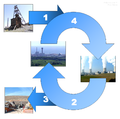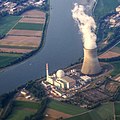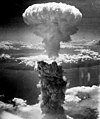Portal:Nuclear technology
The Nuclear Technology Portal
Introduction
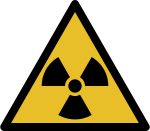
- Nuclear technology is technology that involves the nuclear reactions of atomic nuclei. Among the notable nuclear technologies are nuclear reactors, nuclear medicine and nuclear weapons. It is also used, among other things, in smoke detectors and gun sights. (Full article...)
- Nuclear power is the use of nuclear reactions to produce electricity. Nuclear power can be obtained from nuclear fission, nuclear decay and nuclear fusion reactions. Presently, the vast majority of electricity from nuclear power is produced by nuclear fission of uranium and plutonium in nuclear power plants. Nuclear decay processes are used in niche applications such as radioisotope thermoelectric generators in some space probes such as Voyager 2. Reactors producing controlled fusion power have been operated since 1958, but have yet to generate net power and are not expected to be commercially available in the near future. (Full article...)
- A nuclear weapon is an explosive device that derives its destructive force from nuclear reactions, either fission (fission bomb) or a combination of fission and fusion reactions (thermonuclear bomb), producing a nuclear explosion. Both bomb types release large quantities of energy from relatively small amounts of matter. (Full article...)
General images -
Selected article -
The laboratory was established in February 1942 to study and use the newly discovered chemical element plutonium. It researched plutonium's chemistry and metallurgy, designed the world's first nuclear reactors to produce it, and developed chemical processes to separate it from other elements. In August 1942 the lab's chemical section was the first to chemically separate a weighable sample of plutonium, and on 2 December 1942, the Met Lab produced the first controlled nuclear chain reaction, in the reactor Chicago Pile-1, which was constructed under the stands of the university's old football stadium, Stagg Field.
The Metallurgical Laboratory was established as part of the Metallurgical Project, under the S-1 Committee, and also known as the "Pile" or "X-10" Project, headed by Chicago professor Arthur H. Compton, a Nobel Prize laureate. In turn, it became part of the Manhattan Project – the Allied effort to develop the atomic bomb during World War II. The Metallurgical Laboratory was successively led by Richard L. Doan, Samuel K. Allison, Joyce C. Stearns and Farrington Daniels. Scientists who worked there included Enrico Fermi, James Franck, Eugene Wigner and Glenn Seaborg. Compton assigned Robert Oppenheimer to take over the research into bomb design in June 1942, and that became the separate Project Y in November. At its peak on 1 July 1944, the Met Lab had 2,008 staff.
Chicago Pile-1 was soon moved by the lab to Site A, a more remote location in the Argonne Forest preserves, where the original materials were used to build an improved Chicago Pile-2 to be employed in new research into the products of nuclear fission. Another reactor, Chicago Pile-3, was built at the Argonne site in early 1944. This was the world's first reactor to use heavy water as a neutron moderator. It went critical in May 1944, and was first operated at full power in July 1944. The Metallurgical Laboratory also designed the X-10 Graphite Reactor at the Clinton Engineer Works in Oak Ridge, Tennessee, and the B Reactor at the Hanford Engineer Works in the state of Washington.
As well as the work on reactor development, the Metallurgical Laboratory studied the chemistry and metallurgy of plutonium, and worked with DuPont to develop the bismuth phosphate process used to separate plutonium from uranium. When it became certain that nuclear reactors would involve radioactive materials on a gigantic scale, there was considerable concern about the health and safety aspects, and the study of the biological effects of radiation assumed greater importance. It was discovered that plutonium, like radium, was a bone seeker, making it especially hazardous. The Metallurgical Laboratory became the first of the national laboratories, the Argonne National Laboratory, on 1 July 1946. The work of the Met Lab also led to the creation of the Enrico Fermi Institute and the James Franck Institute at the university. (Full article...)
Selected picture -
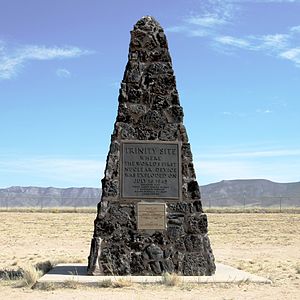
The black plaque on top reads:
Trinity Site
Where The World's First Nuclear Device Was Exploded On July 16, 1945
Erected 1965 White Sands Missile Range J. Frederick Thorlin Major General U.S. Army Commanding
The gold plaque below it declares the site a National Historic Landmark, and reads:
Trinity Site has been designated a National Historical Landmark
This Site Possesses National Significance In Commemorating The History of the United States of America
1975 National Park Service United States Department of the Interior
Did you know?
- ... that according to witnesses, the plutonium charge in the bomb used in the nuclear weapons test Gerboise Verte was transported in an economy car?
- ... that during World War II, pilot G. E. Clements was removed from training for secret missions associated with the Manhattan Project when senior officers realized she was a woman?
- ... that T. K. Jones thought that a nuclear war was survivable if "there are enough shovels to go around"?
- ... that plutonium produced in the nuclear reactors at the Hanford Engineer Works was used in the Fat Man bomb used in the atomic bombing of Nagasaki in August 1945?
- ... that coral cores from Flinders Reef capture environmental changes caused by the use of nuclear weapons?
- ... that the area of Cultybraggan Camp has been a royal hunting ground, a prison for fervent Nazis and the site of an underground bunker intended for use in a nuclear war?
Related WikiProjects
Things you can do
| Parts of this portal (those related to section) need to be updated. Please help update this portal to reflect recent events or newly available information. Relevant discussion may be found on the talk page. (September 2021) |
Selected biography -
Bohr developed the Bohr model of the atom, in which he proposed that energy levels of electrons are discrete and that the electrons revolve in stable orbits around the atomic nucleus but can jump from one energy level (or orbit) to another. Although the Bohr model has been supplanted by other models, its underlying principles remain valid. He conceived the principle of complementarity: that items could be separately analysed in terms of contradictory properties, like behaving as a wave or a stream of particles. The notion of complementarity dominated Bohr's thinking in both science and philosophy.
Bohr founded the Institute of Theoretical Physics at the University of Copenhagen, now known as the Niels Bohr Institute, which opened in 1920. Bohr mentored and collaborated with physicists including Hans Kramers, Oskar Klein, George de Hevesy, and Werner Heisenberg. He predicted the properties of a new zirconium-like element, which was named hafnium, after the Latin name for Copenhagen, where it was discovered. Later, the synthetic element bohrium was named after him.
During the 1930s, Bohr helped refugees from Nazism. After Denmark was occupied by the Germans, he met with Heisenberg, who had become the head of the German nuclear weapon project. In September 1943 word reached Bohr that he was about to be arrested by the Germans, so he fled to Sweden. From there, he was flown to Britain, where he joined the British Tube Alloys nuclear weapons project, and was part of the British mission to the Manhattan Project. After the war, Bohr called for international cooperation on nuclear energy. He was involved with the establishment of CERN and the Research Establishment Risø of the Danish Atomic Energy Commission and became the first chairman of the Nordic Institute for Theoretical Physics in 1957. (Full article...)
Nuclear technology news
- 19 November 2024 – Russian invasion of Ukraine
- Nuclear risk during the Russian invasion of Ukraine, Russia and weapons of mass destruction
- Russian President Vladimir Putin signs a decree that allows Russia to use nuclear weapons in response to conventional attacks by a non-nuclear state supported by a nuclear power. (Reuters)
- 5 November 2024 – Fukushima nuclear accident
- A remote-controlled robot retrieves a piece of melted fuel from the Fukushima Daiichi Nuclear Power Plant, the first time a piece of melted fuel has been retrieved from a nuclear meltdown. (AP)
Related portals
Related topics
Subcategories
Associated Wikimedia
The following Wikimedia Foundation sister projects provide more on this subject:
-
Commons
Free media repository -
Wikibooks
Free textbooks and manuals -
Wikidata
Free knowledge base -
Wikinews
Free-content news -
Wikiquote
Collection of quotations -
Wikisource
Free-content library -
Wikiversity
Free learning tools -
Wiktionary
Dictionary and thesaurus














































